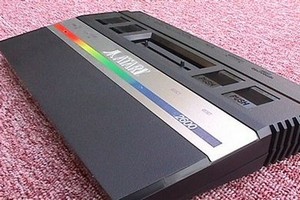| |
During this period, Atari continued to grow until it had one of the largest R&D divisions in Silicon Valley. They spent much of their R&D budget on projects that seemed rather out of place at a videogame (or even home computer) company; many of these projects never saw the light of day. Meanwhile, several attempts to bring out newer consoles failed for one reason or another, although their home computer systems, the Atari 8-bit family, sold reasonably, if not spectacularly. Warner was more than happy anyway, as it seemed to have no end to the sales of the 2600, and Atari was responsible for over half of the company's income.
The programmers of many of Atari's biggest hits grew disgruntled with the company for not crediting game developers. For example, Rick Mauer, the programmer of Atari 2600 Space Invaders, received no credit and made only $11,000 for his efforts, in spite of the cartridge grossing more than $100 million in sales. Most notably, Warren Robinett, the lead programmer of Adventure, in protest against Atari's anonymity policy, hid his name in a secret room within the game. This was one of the first "Easter eggs"—a hidden treat or in-joke—a practice which continues in software development to this day. Many other programmers left the company and formed their own independent software companies. The most prominent and longest-lasting of these third-party developers was Activision, founded in 1980, whose titles quickly became more popular than those of Atari itself. Atari attempted to block third-party development for the 2600 in court but failed, and soon other publishers, such as Imagic and Coleco, entered the market. Atari suffered from an image problem when a company named Mystique produced a number of pornographic games for the 2600. The most notorious of these, Custer's Revenge, caused a large number of protests from women's and Native American groups. Atari sued Mystique in court over the release of the game.
Atari continued to scoop up licenses during the shelf life of the 2600, the most prominent of which included Pac-Man and E.T. Public disappointment with these two titles and the market saturation of bad third-party titles are cited as big reasons for the video game crash of 1983. Suddenly, Atari's growth meant it was losing massive amounts of money during the crash, at one point about $10,000 a day. Warner quickly grew tired of supporting the now-headless company, and started looking for buyers in 1984. |
|
|









